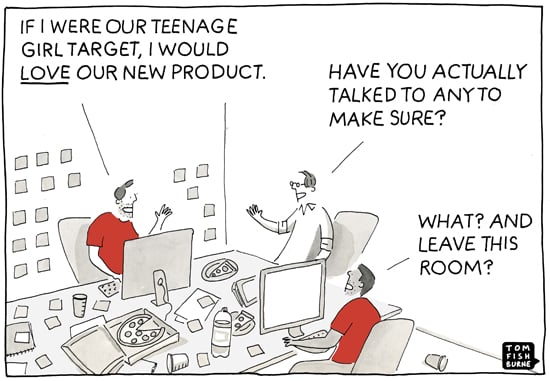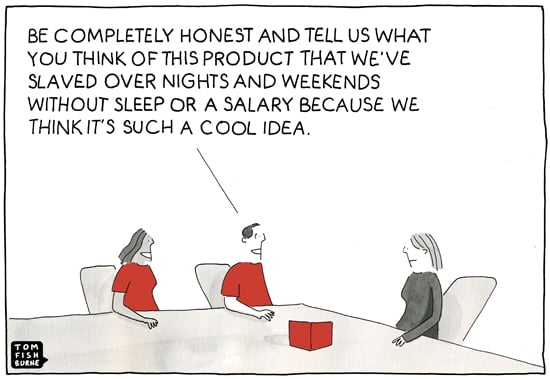Customer Interviews: Why You Should Keep Doing Them
by Lina Panahi, on 4 May 2021
Supposing is good, but finding out is better. – Mark Twain
Your business is thriving. You're making revenue. Your business from repeat customers is increasing, too.
Before you get too comfortable and assume you’ve solved all of your customers’ problems, it might be time to do some customer interviews.
Remember you did those when you first started? Well, there are many good reasons to continue doing customer interviews as your business grows.
In this post we’ll explore why and how.

THE WHY
Customer interviews take time and resources. You’re probably wondering: why go through the trouble? Here are some of the benefits:
Uncover customer practices you didn’t consider.
It may seem odd to “follow” your customer, but by observing them actually using your product (as opposed to just asking them about it) you may discover them using it in a way you never expected.
In the early 1980s, Scott Cook, the founder of Intuit, famously pioneered the Follow Me Home tactic to better understand his customers.
As you walk through the mall toward your car, a nicely dressed man stops you and introduces himself as Scott, a computer programmer who has a piece of software that will simulate the experience of a paper checkbook on your new computer. All he wants to do is watch how you install and use this new program he’s working on called “Quicken.”
- From the Intuit Blog
Identify new audiences.
As your business continues to expand, you’ll want to identify follow-on market opportunities.
You probably have multiple market segments you can consider, but how do you know which one to start with?
Customer interviews will help de-risk entry into new markets and give you confidence that you’re headed in the right direction.
Develop a relationship with your customers.
Even if all of your assumptions are correct, and you don’t leave with any new information (unlikely!), your time with customers shows dedication and care about their experience.
BEFORE THE INTERVIEW
Make the time with your customers worthwhile and this requires preparation.
A good place to start is by figuring out what you want to learn from your customers. Choose 2-3 objectives.
Once you are going through the process and learning more, you can always adjust.
The second step is coming up with an interview guide and plan.
This involves figuring out how you’ll structure your interview, the questions you will ask, and who on your team will be present.
It is helpful to have someone take notes because it is difficult to have an authentic, organic conversation if you’re taking notes at the same time.
Recording the interview is also an option, but can make some interviewees uncomfortable. You’ll also have to put in additional effort to revisit the recording and transcribe important parts.
The third part is figuring out which of your customers to interview.
One approach is to look for extreme users. Alternatively, select a few of your most loyal fans.
You’ll want to find out what it is about your product or service that they love so much and which features they use the most and least.
On the other end, select a few from the “bottom” – your least engaged customers.
You’ll want to find out why their engagement is so low. Is it because they haven’t fully integrated your solution into their workflow? Are they not getting the value they wanted and expected?

DURING THE INTERVIEW
Now you’re ready to meet with customers.
The types of questions you ask are crucial to the outcome of the interview, so here are some Do’s and Don’ts to consider:
- Don’t pitch your product. This is not the time to showcase your latest PowerPoint presentation or demo. The purpose of this conversation is to gather as much valuable raw information as you can from the customer.
- Don’t ask leading questions. If you frame the wording of your questions to get the answers you’re looking for, then you won’t get true, unbiased feedback. Here are some examples:
- How much do you enjoy our service?
- Do you think this is cool?
- Why do you think we’re better than our competitors?
As an interviewee, it’s obvious what types of answers you’re looking for, and to avoid disappointing you, they’ll likely provide biased responses.
- Do ask for stories and open ended questions. You want to build a comfortable, fluid dialog with your interviewee. There’s so much to learn when people tell stories. Here are a few examples of questions that can provoke stories:
- Tell me about the last time X happened.
- How has X changed over time?
- What shortcuts or tools have you created to help you work with X?
- Show us the process of X.
- Who are all the people involved in X? What role do they play in the process?
During the interview, pay attention to their tone of voice, body language, and facial cues to better understand the feelings behind their statements.
Besides emotional subtext, did they mention that they had to create workarounds or hacks to get around limitations in your solution?
At the end of the interview, ask if you can follow up with them in the future. This not only strengthens your relationship but gives you an opportunity to interview them again to see if things you’ve resolved really worked.
It’s also helpful to ask who else in the company they suggest you talk to.
AFTER THE INTERVIEW
Phew! You made it through the interview, but the work is not done. Now it’s time to look at all the data you gathered and identify themes.
What patterns did you notice? What are the high points and low points that you saw multiple customers mention?
Take any patterns you identified and synthesize them into key learnings.
Share what you’ve learned with your team and pass along the customers’ stories without your bias (as much as possible.)
Distill the key learnings into actionable items and prioritize them.
There will be a lot of factors to consider when prioritizing the list and you won’t be able to fix all your customers’ problems right away, so keep in mind what is most important to them.
Finally, remember that this is a learning process – one that takes practice and iteration. However, you will be rewarded with increased customer satisfaction and their loyalty.
Recommended Reading:
The Mom Test, by Rob Fitzpatrick (Amazon | Bookshop)
Talking to Humans, by Giff Constable (Amazon)
OTHER RECOMMENDED POSTS
Customer Journey Mapping – Are We There Yet?
The Proof of Concept Paradox
3 Ways To Keep Up With Your Customers



